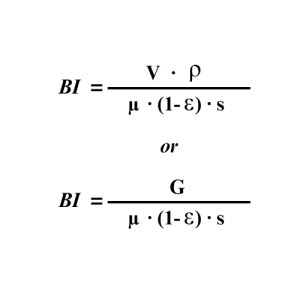

Blake Number Calculator
Permeability Index (BI):
Permeability Index (BI):
Blake Number
The Blake number (Bl) is a dimensionless parameter used in fluid mechanics to characterize the relative importance of inertial forces to viscous forces in a fluid flow situation. It’s named after the British engineer and mathematician Stephen Blake.
Blake number is proportional to { (inertial force) / (viscous force) } and is used in momentum transfer in general and flow through beds of solids calculations in particular. It is normally defined in one of the following forms :
Where: | ||
epsilon | = | Void fraction |
G | = | Mass velocity |
mu | = | Viscosity |
rho | = | Density |
s | = | Particle area/particle volume |
V | = | Velocity |
The Blake number helps determine whether inertia or viscosity dominates the fluid flow behavior. Depending on the value of the Blake number, different flow regimes can be identified:
- If Bl ≪ 1, viscous forces dominate over inertial forces, and the flow behavior is primarily determined by viscosity. This typically occurs in situations where the fluid’s inertia is negligible, such as in highly viscous or slow-flowing fluids.
- If Bl ≫ 1, inertial forces dominate over viscous forces, and the flow behavior is primarily determined by inertia. This typically occurs in situations where the fluid’s inertia is significant, such as in high-speed flows or turbulent flows.
The Blake number is commonly used in the analysis of various fluid flow problems, including pipe flow, boundary layer flows, and turbulent flows. It helps engineers and scientists understand and predict the behavior of fluids under different flow conditions.
